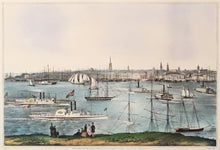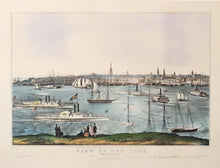F.F. Palmer. (1812-1876) "View of New York from Brooklyn Heights."
New York: N. Currier, 1849. 11 1/2 x 17 1/8. Lithograph. Original hand color. Very good condition. First state. C: 6402.
From 1834 to 1907 the firm of Currier & Ives provided for the American people a pictorial history of their country’s growth from a agricultural society to an industrialized one. For nearly three quarters of a century the firm provided “Colored Engravings for the People” and in the process, because of the democratic philosophy of the business, became the visual raconteurs of nineteenth century America.
In 1834 Nathaniel Currier established the firm which produced colored pictures using a then relatively new process called lithography. Some of the finest artists of the day, Louis Maurer, Thomas Worth, Arthur Fitzwilliam Tait, Frances Flora Bond Palmer, George H. Durrie, Napoleon Sarony, Charles Parsons, and J. E. Butterworth were engaged by the firm to produce a variety of images. The prints were printed in black and white and then the finest colors, imported from Austria, were applied by hand by women, most of German descent. They were then ready for both foreign and domestic distribution through a variety of means, one of which included push cart vendors who walked through the streets, prints tacked upon their carts, selling them for a few cents each.
This is of the “stock” print genre which depicts a scene of New York City from Brooklyn Heights. Two groups of sightseers and an assortment of boats and ships plying the East River are shown in the foreground, with the steeples and towers of New York in the mid-nineteenth century in the background. Overall, this is a particularly desirable example of the firm’s stock in trade in Americana.





